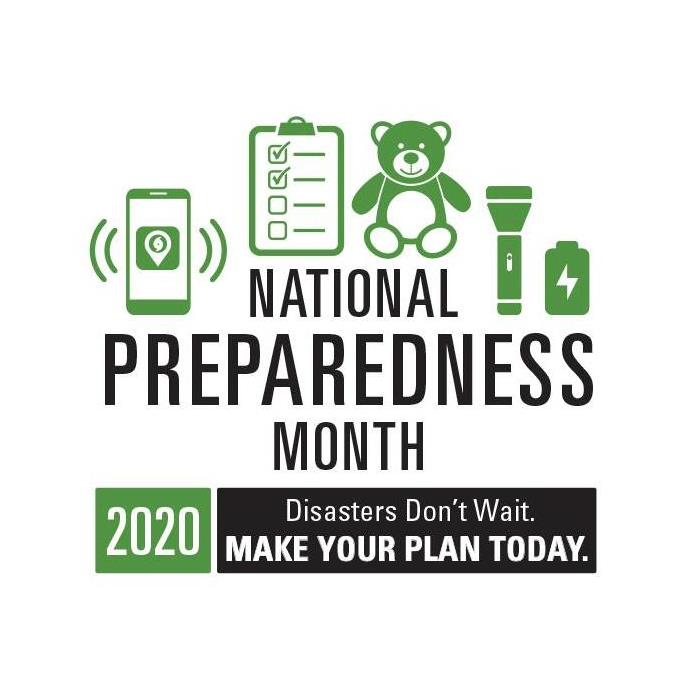Recent Community Posts
Are your Pets Emergency Ready?
8/31/2022 (Permalink)
 Make sure you make a pet emergency kit
Make sure you make a pet emergency kit
This month is National Emergency Preparedness Month and we are following up today to give you pet and animal safety and planning advice for emergency situations. In an emergency situation you want to make sure your furry family member is included in your emergency planning.
- Make a Pet Emergency Plan:
- ID your pet. Make sure your pet’s tags are up-to-date and securely fastened to your pet's collar. If possible, attach the address and/or phone number of your evacuation site. If your pet gets lost, his tag is his ticket home. Also consider microchipping your pets.
- Make sure you have a current photo of your pet for identification purposes.
- Make a pet emergency kit. Download Preparing Makes Sense for Pet Owners for a full list of items to include in your pets kit.
Check out this quick list:
- Pet food
- Bottled water
- Medications
- Veterinary records
- Cat litter/pan
- Manual can opener
- Food dishes
- First aid kit and other supplies
- Identify shelters. For public health reasons, many emergency shelters cannot accept pets. Find out which motels and hotels in the area you plan to evacuate to allow pets well in advance of needing them. There are also a number of guides that list hotels/motels that permit pets and could serve as a starting point. Include your local animal shelter's number in your list of emergency numbers.
- Make sure you have a secure pet carrier, leash or harness for your pet so that if he panics, he can't escape.
- Prepare Shelter For Your Pet:
- Call your local emergency management office, animal shelter or animal control office to get advice and information.
- If you are unable to return to your home right away, you may need to board your pet. Find out where pet boarding facilities are located. Be sure to research some outside your local area in case local facilities close.
- Most boarding kennels, veterinarians and animal shelters will need your pet's medical records to make sure all vaccinations are current. Include copies in your "pet survival" kit along with a photo of your pet.
- Some animal shelters will provide temporary foster care for owned pets in times of disaster but this should be considered only as a last resort.
- If you have no alternative but to leave your pet at home, there are some precautions you must take, but remember that leaving your pet at home alone can place your animal in great danger! Confine your pet to a safe area inside – NEVER leave your pet chained outside! Leave them loose inside your home with food and plenty of water. Remove the toilet tank lid, raise the seat and brace the bathroom door open so they can drink. Place a notice outside in a visible area, advising what pets are in your home and where they are located. Provide a phone number where you or a contact can be reached as well as the name and number of your vet.
- Protect Your Pet During A Disaster:
- Bring your pets inside immediately.
- Have newspapers on hand for sanitary purposes. Feed animals moist or canned food so they will need less water to drink.
- Animals have instincts about severe weather changes and will often isolate themselves if they are afraid. Bringing them inside early can stop them from running away. Never leave a pet outside or tied up during a storm.
- Separate dogs and cats. Even if your dogs and cats normally get along, the anxiety of an emergency situation can cause pets to act irrationally. Keep small pets away from cats and dogs.
- In an emergency, you may have to take your birds with you. Talk with your veterinarian or local pet store about special food dispensers that regulate the amount of food a bird is given. Make sure that the bird is caged and the cage is covered by a thin cloth or sheet to provide security and filtered light.
- If you evacuate your home, DO NOT LEAVE YOUR PETS BEHIND! Pets most likely cannot survive on their own and if by some remote chance they do, you may not be able to find them when you return.
- If you are going to a public shelter, it is important to understand that animals may not be allowed inside. Plan in advance for shelter alternatives that will work for both you and your pets; consider loved ones or friends outside of your immediate area who would be willing to host you and your pets in an emergency.
- Make a back-up emergency plan in case you can't care for your animals yourself. Develop a buddy system with neighbors, friends and relatives to make sure that someone is available to care for or evacuate your pets if you are unable to do so. Be prepared to improvise and use what you have on hand to make it on your own for at least three days, maybe longer.
- Caring For Your Pets After A Disaster:
- If you leave town after a disaster, take your pets with you. Pets are unlikely to survive on their own.
- In the first few days after the disaster, leash your pets when they go outside. Always maintain close contact. Familiar scents and landmarks may be altered and your pet may become confused and lost. Also, snakes and other dangerous animals may be brought into the area with flood areas. Downed power lines are a hazard.
- The behavior of your pets may change after an emergency. Normally quiet and friendly pets may become aggressive or defensive. Watch animals closely. Leash dogs and place them in a fenced yard with access to shelter and water.
- Tips for Large Animals:
If you have large animals such as horses, cattle, sheep, goats or pigs on your property, be sure to prepare before a disaster.
- Ensure all animals have some form of identification.
- Evacuate animals whenever possible. Map out primary and secondary routes in advance.
- Make available vehicles and trailers needed for transporting and supporting each type of animal. Also make available experienced handlers and drivers. Note: It is best to allow animals a chance to become accustomed to vehicular travel so they are less frightened and easier to move.
- Ensure destinations have food, water, veterinary care and handling equipment.
- If evacuation is not possible, animal owners must decide whether to move large animals to shelter or turn them outside.
Be sure to stay tuned for other Emergency Preparedness Tips and Activities. Also, be sure to check out our other blogs for useful information and services that SERVPRO of Tarrytown/Elmsford offers. If you have any questions or would like further information please call our office at 914-358-9000 or email us at SERVPRO9937@jdcrestoration.com.
Does Your Business Have a Plan?
3/22/2021 (Permalink)
When an emergency occurs, the first priority is always life safety. The second priority is the stabilization of the incident. There are many actions that can be taken to stabilize an incident and minimize potential damage. First aid and CPR by trained employees can save lives. Use of fire extinguishers by trained employees can extinguish a small fire. Containment of a small chemical spill and supervision of building utilities and systems can minimize damage to a building and help prevent environmental damage.
Some severe weather events can be forecast hours before they arrive, providing valuable time to protect a facility. A plan should be established and resources should be on hand, or quickly, available to prepare a facility. The plan should also include a process for damage assessment, salvage, protection of undamaged property and cleanup following an incident. These actions to minimize further damage and business disruption are examples of property conservation.
Helping Schools
2/8/2021 (Permalink)
 Let us clean and sanitize so you can get back to what's important, teaching!
Let us clean and sanitize so you can get back to what's important, teaching!
Educational institutions can depend on their local SERVPRO of Tarrytown/Elmsford Professional for fast, thorough service in the event of fire, water or mold damage.
With 24-hour emergency response, SERVPRO® of Tarrytown and Elmsford Professionals provide mitigation, cleanup and restoration services to reduce recovery costs and to help ensure minimal interruption to your curriculum. Your local SERVPRO® of Tarrytown and Elmsford Professional also provides expert cleaning for emergencies or special needs exceeding routine janitorial capabilities, including stain removal, upholstery and drapery dry cleaning, indoor air quality and vandalism cleanup.
Our Franchise Professionals are trained to clean and sanitize building materials, surfaces and contents following restoration industry standards, using professional cleaning products and EPA registered cleaners and disinfectants.
So don't wait, call SERVPRO® of Tarrytown and Elmsford at (914) 358-9000 today!
Toys for Tots Collection Campaign
11/20/2020 (Permalink)
 Toys For Tots Poster with children's wooden train
Toys For Tots Poster with children's wooden train
We are excited to announce that SERVPRO of Tarrytown/Elmsford's Toys for Tots collection campaign has begun and will last until Friday December 18th.
Toy distribution takes place mid to late December. We encourage members of the community to mail/drop off a new unwrapped toy or a check made payable to the Toys for Tots Foundation.
Coordinators will pick up these toys and store them in central warehouses where the toys are sorted by age and gender. On Christmas, Coordinators, with the assistance of local social welfare agencies, church groups, and other local community agencies, distribute the toys to the less fortunate children of the community.
The Marine Toys for Tots Program distributed 18.6 million toys to 7.3 million less fortunate children during the 2019 Christmas Holiday Season, allowing them to experience the joy of Christmas and receive a message of hope that otherwise would not have been there. This community action program took place in 807 communities covering all 50 States, the District of Columbia, Puerto Rico, Guam, and the Virgin Islands.
Over the years, Marines have established close working relationships with social welfare agencies, churches and other local community agencies which are well qualified to identify the needy children in the community and play important roles in the distribution of the toys.
While Toys for Tots Coordinators organize, coordinate and manage the campaign, the ultimate success depends on the support of the local community and the generosity of the people who donate toys.
We encourage you to help us Fill the big green truck!
Drop off will be available M-F 8AM-5PM at 1000 North Division Street Suite 11A Peekskill, NY 10566. You can also make monetary donations through our Venmo account: @SERVPROoftarrytown. No amount is too big or too small!
If you have any questions do not hesitate to contact our office at 914-358-9000 or via email to SERVPRO9937@jdcrestoration.com.
Halloween Safety Tips
10/1/2020 (Permalink)
 Three Pumpkins Carved out the word "Boo"
Three Pumpkins Carved out the word "Boo"
Decorating for Halloween can bring out creativity in everyone, but many elements of Halloween decorating can pose hazards to unsuspecting visitors. Now is the time to make your home safe for trick-or-treaters. We have gathered some information for you:
- Consider candy choices:No doubt buying Halloween candy is fun, but keep in mind that not all candy is appropriate for every child. Avoid candy that poses a choking hazard for toddlers, and keep in mind that a number of children have peanut allergies. Even if the candy doesn’t contain peanuts, it could be made in a facility that handles peanuts. Check the candy bag’s label for a peanut allergy warning. Also, consider toys and other options for children with other allergies. Some examples are as follows:
- Glow sticks, bracelets, or necklaces
- Pencils, pens, crayons or markers
- Bubbles
- Halloween erasers or pencil toppers
- Mini Slinkies
- Whistles, kazoos, or noisemakers
- Bouncy balls
- Finger puppets or novelty toys
- Coins
- Spider rings
- Vampire fangs
- Mini notepads
- Playing cards
- Bookmarks
- Stickers
- Stencils
The Teal Pumpkin Project is a new project that helps ensure all children on Halloween. How to take part:
- Provide non-food treats (see the list above) for trick-or-treaters.
- Place a teal pumpkin in front of your home to indicate to passersby that you have non-food treats available.
- Display a free printable sign or premium poster from FARE to explain the meaning of your teal pumpkin.
- Say “No” to knives: Don’t let your children handle sharp carving knives and keep an eye on them while you’re carving. If possible, purchase specific tools that are geared just for pumpkin carving (for your safety, too!). If the kids really want to participate in the carving, you can let them make the pattern or poke the pumpkin flesh in after you’ve done the carving.
- Reconsider the candles: A glowing jack-o’-lantern makes your home warm and welcoming to candy seekers, but using a candle to illuminate a pumpkin can be dangerous. Costumes, paper decorations and ornamental straw can easily catch on fire. Instead of a traditional candle, use one powered by batteries or buy a bunch of glow sticks readily available at any party supply or discount store and place them inside your jack-o’-lanterns. They cast an eerie green glow and are safe all around.
- Pay attention: Never leave a candle anywhere unattended, and never leave burning candles where anyone can reach them or accidentally knock them over.
- Blazing fires aren’t allowed: Keep a fire extinguisher handy. You never know when a gourd will go up in smoke.
- Secure the perimeters: Make sure that all props hanging, dangling, draped, staked, or set are steadily secured. Where there will be foot traffic, tape down loose wires with duct tape. You don’t want people to trip. And check these places often during the course of the evening for any loose edges that need fixing.
- Follow the package directions: If a package of lights says that they’re only for indoor use, don’t string them outside. Read the fog machine directions. Take every precaution when it comes to decorating with materials you’re not familiar with.
- Secure your railings: Young children, and the adults who often accompany them, will need the security and support of railings while climbing steps to get to your front door. If you’ve been putting off fixing that rickety railing, it’s time to get out the toolbox and make it secure.
- Make room in the garage: If you’re headed out on Halloween, clean out the garage and store your car securely in it. From teen antics to serious vehicle vandalism and theft, your car is best kept in the garage on Halloween.
- Clear walkways: Trick-or-treaters are too busy counting candy to pay close attention to where they’re walking, so it’s critical to survey your yard for potential trip and slip hazards. Be sure your yard is free of tripping hazards like hoses and sprinklers, clear walkways of loose gravel, and be sure to clean moss off steps. If your home has an irrigation system, turn the system off well in advance of the big night so your lawn and walkways have a chance to dry.
- Use lots of lights: A dimly lit entryway helps set the spooky mood of Halloween, but it’s also increases the chance of an accident. Make sure the exterior lights of your home are working, and consider turning on flood lights to illuminate the darkest areas of your yard. Even if you’re not going to be home, leave on lights for safety reasons and to dissuade unsavory characters from vandalizing your home. And, if you won’t be there, make sure you set your security system, just to be safe.
- Contain your pets: Barking dogs not only scare trick-or-treaters of every age away, they also present a danger. A dog that breaks away from your home might not bite, but he could knock down a toddler or scare a teen right into the street, causing even more danger. Keep all pets securely confined inside your home until the hustle and bustle of the night has passed.
Be sure to check out our other blogs for useful information and services that SERVPRO of Tarrytown/Elmsford offers. If you have any questions or would like further information please call our office at 914-358-9000 or email us at SERVPRO9937@jdcrestoration.com.
Disasters Don’t Wait. Make Your Plan Today.
9/11/2020 (Permalink)
 September is National Preparedness Month
September is National Preparedness Month
Every year, September is recognized as National Preparedness Month in hopes of encouraging families to participate in disaster planning now and throughout the entire year. The Ready.gov website has come up with a timeline for you to use this month in order get yourself and your family prepared in case of a disaster.
Here is a week by week breakdown on what you can do this month to prepare:
Week 1: Make a Plan
It's important for you and your family to know how you will contact each other in case you are separated. Make a plan by discussing topics such us how emergency alerts will be received, what is your evacuation route, shelter plan, and family communication plan. Remember to take into consideration any specific needs of your household. Once you are ready, fill out and print an emergency plan for each of your family members to have.
Week 2: Build a Kit
An emergency kit should have a collection of basic items your household may need in case of an emergency. It should also include any unique items that your family members may need such as supplies for your pets. Click here to download an print a checklist that will help you build your own emergency kit.
Week 3: Prepare for Disasters
Here in the Mid-Atlantic region, we are at a high risk for winter storms and hurricanes. It is important to learn the risks of disasters in your area. Check your insurance coverage and learn how to make your home stronger against those disasters.
Week 4: Teach Youth About Preparedness
Teaching your kids about preparedness may be hard but it is an important step to ensure that you are all prepared in case of an emergency. Involving them in the planning process may be reassuring to them. Visit Ready.gov/Kids for more tools and tips to help teach your kids about preparedness.
We here at SERVPRO of Tarrytown/Elmsford hope that this guide helps you and your family prepare in case of an emergency. As leaders in cleanup and restoration, we are always HERE TO HELP!
Some Fun Activities and Virtual Museum Tours For People of All Ages!
4/1/2020 (Permalink)
 Child's drawing of yellow sun
Child's drawing of yellow sun
This is a stressful time not only for adults, but for children as well. As they stay out of school and out of contact with their peers, its important to keep their little bright minds engaged!
Below are some links for you to enjoy with children of all ages as well as some museums which offer free virtual tours!
Scholastic Magazine: online learning: *look for username & password to access free lessons*
https://classroommagazines.scholastic.com/support/learnathome.html
San Diego Zoo-activities and live animal cameras:
https://zoo.sandiegozoo.org/live-cams
https://kids.sandiegozoo.org/
Discovery education- space exploration:
https://www.boeingfutureu.com/virtual-field-trip
Discovery education- polar bear
https://youtu.be/3pI22Seiqag
12 world-famous museums are offering "virtual" tours online:
• British Museum, London
• Guggenheim Museum, New York
• National Gallery of Art, Washington, D.C.
• Musée d’Orsay, Paris
• National Museum of Modern and Contemporary Art, Seoul
• Pergamon Museum, Berlin
• Rijksmuseum, Amsterdam
• Van Gogh Museum, Amsterdam
• The J. Paul Getty Museum, Los Angeles
• Uffizi Gallery, Florence
• MASP, São Paulo
• National Museum of Anthropology, Mexico City
Mystery Science - science lessons:
https://mysteryscience.com/school-closure-planning
Smart Music-music education:
https://www.smartmusic.com/
Raddish- kids cooking:
https://www.raddishkids.com/ (Free kits currently sold out)
loads of free sources/subscription:
www.amazingeducationalresources.com/
more links to online activities:
https://mommypoppins.com/family/coronavirus-pandemic-update-indoor-activities-resources-kids
CoderZ- STEM & coding:
https://gocoderz.com/
Metropolitan Opera: free opera streaming :https://www.metopera.org/about/press-releases/met-to-launch-nightly-met-opera-streams-a-free-series-of-encore-live-in-hd-presentations-streamed-on-the-company-website-during-the-coronavirus-closure/
We hope this brings a little sunshine to your day!






 24/7 Emergency Service
24/7 Emergency Service





